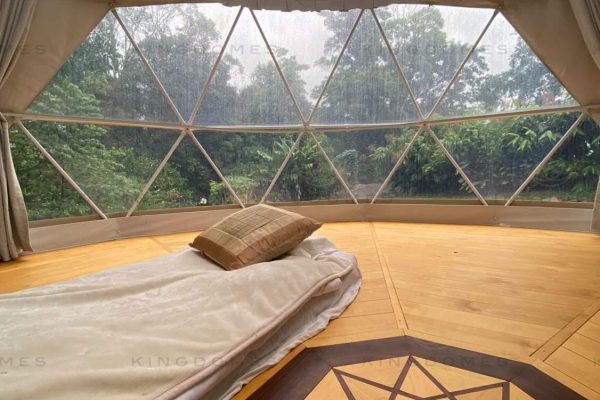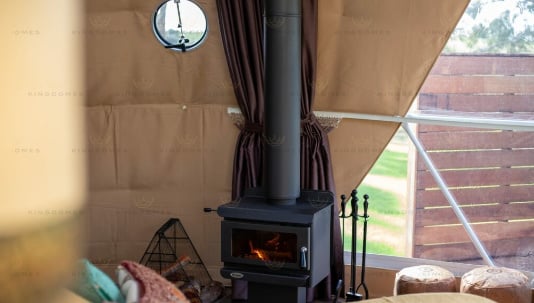We specialize in transforming rural spaces into premier eco-tourism destinations through our high-end dome structures. Catering to property owners, wellness advocates, and creative minds, we offer a bespoke solution that turns your vision into a profitable reality. Our domes are more than structures; they’re gateways to wellness, retreat, and sustainable luxury. Let us help you lead in the eco-tourism and wellness sectors, making a lasting impression on your guests and the environment
Thanks for seeing us NSW
Ready to dive deeper? While you can download our brochure directly using the ‘Download Our Brochure’ button, why stop there? By signing up for our emails, you’ll not only receive the brochure but also gain exclusive access to valuable resources including our comprehensive glamping e-book, step-by-step guides on building your dome, financing options, inspiring stories from our clients, and much more. If you’re interested in transforming your space with innovative ideas and practical advice, fill out the form below and start your journey with us today!
You know how some people look at an open field and see, well, an open field? And then there are folks like us who see it and think, “I could fit so many luxury glamping domes in here, it’s not even funny.” (Actually, it is funny. Maybe a little disturbing as well, but primarily funny.)
Who the Dome Are We?
We’re Kingdomes, the Monet of luxury domes. Alright, we don’t paint lily ponds, but we do transform your average, everyday land into something out of a glamping magazine. Imagine your own dome with a fireplace. Throw in a kitchenette if you’re feeling “culinary.” Heck, put in a mezzanine if you want to look down on people—literally.
What Do We Do?
We give people the chance to level up their property and their lifestyle. Got land? We’ve got the dome to match it. From rustic authentic escapes to 5-star eco-resorts, we’ve got a size and style for every taste and location. (Even our friends in NZ aren’t missing out on this!)
Who Buys These, anyway?
The trendsetters. The ROI-chasers. People who want more than just grass and dirt on their property. People who want an ROI that even their accountant would smile at. People who aspire to make their neighbours say, “Wow, what is that? I want one.”
It is a shame that we have to watermark all of our photos but that is because people love to use our images without our permission. All the content on our website is ours (or our lovely clients gracious enough to let us use them) and we do not take credit at all for other people’s work.
Some FAQs
How long do your domes last?
Depending on multiple factors such as UV, direct sunlight, air pollution, how often the cover gets cleaned etc, you should expect to get between 8-15 years life expectancy on the cover. (to keep it easy, let’s just say you’ll get a decade out of a cover before it needs replacing unless you are in very harsh conditions). Having the dome in partial shade and being on top of general cleaning schedules (we recommend every 2-4 months depending on air-quality) will help to maximise the life expectancy of the cover.
As the frame is made from powder-coated steel, this should last indefinitely, provided that there are no scratches on the frame or chips in the paint. We use thicker steel than most of our competitors (this becomes evident in sections like the door frame and the individual bars on our larger ranges). Every if signs of rust begin to occur, sanding it back and touching up with paint can help to slow/stop the oxidisation process.
Are the domes waterproof?
The entire cover is waterproof (and is one piece so will not leak in between welds in the cover). We do also have provisions for sealing around the bottom perimeter of the dome as well. Waterproofing qualities will depend on the level of siliconing around pentrative accessories such as our windows, doors, solar extraction fans etc. Though typically not essential, we do recommend running a line of silicone around the perimeter of the dome (from inside) for extra barrier protection.
What do council have to say about them?
I will be covering this more in-depth at a later stage because unfortunately there is no simple answer to this. (If at the time you are reading this, we have already created this and I haven’t updated this section then apologies).
In short, our domes fall under 3 classifications here in Australia. They are:
- moveable dwellings
- temporary structures
- tents (funnily enough)
This essentially means that they do not fall under the same regulations as permanent dwellings. Some states do have various forms of exempt development codes that these can fall under that don’t require council approval.
Depending on the use however (public use especially) the council will want to ensure the safety of the public inside and so it isn’t typically the structure itself but more-so what it sits on, grey/black water systems, mains connections etc.
Other factors like can include (this is again, not specific to domes but the entire project):
- Bushfire Attack Level Assessment
- fire management
- how the property will be sourced with potable water
- Effluent control
- Environmental impacts
- Waste management
- Traffic management
A good 80-90% of our clients are under the mentality (and rightly so in my opinion) that they own the land so they should be able to do whatever they bloody want to on it (within reason of course) and so have not bothered with council approval. For legal purposes (unfortunately) we cannot recommend this in case it comes back to bite us in the arse.
I will say something that is “completely out of context” and that is “seek forgiveness rather than seek permission. Document everything that you do and make sure that whatever it is that i am talking about (again, completely out of context, like why am I even saying this?) is up to standards and regulations where necessary.”
Do you ship Australia Wide?
- absolutely (that was easy)
Do you Ship to NZ?
To all my kiwi Whanau across the ditch, we absolutely can.
Do you Ship to other countries?
With the invention of cargo ships, anything is possible. Please contact us directly to further your enquiry into this and we’ll see what we can do.
Surely the domes get hot in summer. Is that true?
There is a huge misconception around our domes being immensely hot in summer. While yes, at first glance they are still ‘tents,’ our accessories make sure that that status is only of a legal sense. With our insulation, solar extraction fans, ventilation ports, black-out curtains and various window options, it can definitely keep the temperature cool inside.
The biggest factor in heat are:
- the clear sections of our domes (bay window and central skylight). The only real negative feedback we have received is that the central skylight draws too much heat so we have removed this from our standard range. If you still want a skylight, we now give extra insulation panels to cover the skylight in the warmer months. In winter, the skylight is a great addition to warming up the internals but it does get quite hot in summer. The black out curtains act as a barrier of the harsh UV rays belting down and warming up the clear section of the bay window. My best suggestion is to not face the bay window toward the harsh arvo sun as much as possible.
- Stagnant air. Taking you back to 8th grade science class (or even earlier for some of you gifted and talented folk), you were taught that hot air rises (it isn’t magic that lifts hot-air balloons off the ground unfortunately, actually I feel it is a bit of both.)
With our domes boasting up to 5m in roof height as well as being aided with the solar fans sucking the air through the roof and our ventilation ports allowing airflow between the inside and outside air, this helps to minimise this. However, until those beautiful southern winds come through, blowing all this hot air out, the air around you may still be still (if that makes sense, I dunno I may have been asleep for that class).
How do I move still air you might ask? Fans, A/C or flap your arms really quickly (and wave em like you just don’t care) to move that internal air. Opening everything up is the best bet for those with off-grid set ups (A/C can chew up a lot of power, fans, not so much).
How about in winter though?
The bay window and cnetral skylight (if you have one) can help to keep a beautiful temperature in the dome during the day. “But Kingdomes, that is great and all but what about at the end of the day when the sun disappears?” Don’t worry your cute little warm butt reader, as we have solutions for that. We have worked with partners to create chimney plates that tick Aussie standards boxes to ensure you and your guests are comfy and safe during those cold nights.
Other methods (that use electricity, so again, be mindful off-gridders) are A/C, heaters and underfloor heating. The insulation helps to trap the heat internally as well. If you in extremely cold areas though, we do also remember installing insulated flooring during the construction stage (especially if on a deck).
Can you leave the domes up full time?
Not only can you do it, we recommend it. Putting all that time and effort into creating a luxury unique glamping experience, only to pack it up a few months later sounds like an absolute drag. I don’t know about you, but I’d much rather keep getting booked up throughout the year rather than figuring out where I put the spare set of cutlery, specifc to dome 3 (was it in the shed or at Storage King?)
I have what I feel is a completely rational fear of snakes and spiders but me mate Davo keeps calling me a wimp. If I am staying in one of your domes, do I have to fear this conversation being brought up again due to me hitting the Whitney Houston note for seeing something with 8 legs?
Creepy-crawlies however can be a different story. Have you seen the video of a Huntsman Squeezing through a gap in a car in Adelaide? (Seriously, go check it out, I’ve linked it here). The sealing capabilities of the dome will be determinded by the foundation it sits on and how well the accessories and bottom perimeter or the dome has been sealed. Personally, I prefer spiders to bloody flies and mozzies but each to their own.
How are you Kingdomes?
We are so glad you asked. We are doing well, thank you very much for your concern. We hope you are well too 😀 Cheers, Jesse and Ash from Kingdomes <3
Last Chance to Master the Fine Art of Glampreneurship!
Before you ride off into the glamping sunset, wouldn’t you like a treasure map—or three—for your journey? We’ve got the golden nuggets to make you the Sultan of Glampistan, the Queen of Eco-Luxe, or the Emperor of Domeville! (Titles pending, but you get the idea!)
📚 Final Call to Snag These Freemium Docs:

-
Our irresistible ‘Glamping 101: 10 Pro Tips to Build Your Dream Glamping Business’ E-Book
-
The legendary ‘Stages of a King Dome Build’ E-Book
- And other essential loot that’ll be your compass in the glamping wilderness!













































































